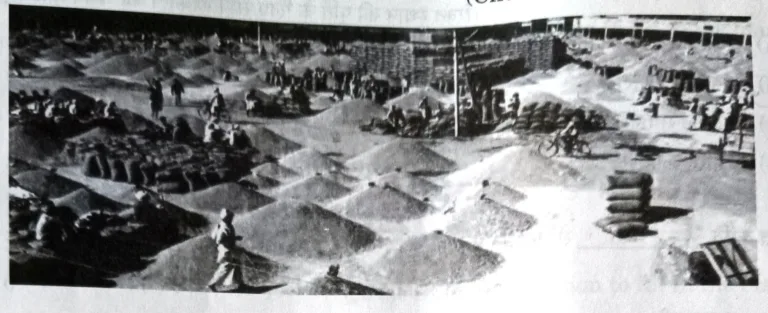CBSE Class 12 Economics Answer Keys 2025

Hello Students,
On 19.03.2025, CBSE conducted final exam of Economics for Class 12 at various centers all over India. As usual we are providing you CBSE Class 12 Economics Answer Keys 2025. These answer keys pertains to Economics Paper Code 58/6/1. All the MCQs appeared in the paper have been covered.
Earlier, we have also provided answer keys of various subjects of Class 10 and Class 12 exams of which have already been conducted by the CBSE. If you have not checked those answer keys, you can check them on our website cbsestudent.com under Answer Key menu.
Present answer keys of Economics Paper Code 58/6/1 have been prepared by subject expert having immense experience in teaching class 12 students of economics. Due care will be taken to prepare the answer keys so that students are able to estimate their marks in final exams.
We have provided answer keys with brief explanation so that students can know the reason behind the right answer.
Keep Refreshing the page, Explanation is also being added to answer keys
Q.1 If the value of investment multiplier is 5, the relevant saving function would be____________.
ANSWER
Answer: Option (C) is correct. (-60 + 0.20Y)
Brief Explanation: Investment Multiplier Formula with respect to MPS is:
k (investment multiplier) = 1/MPS
5 = 1/MPS
MPS = 1/5 = 0.20
Q.2 Identify which of the following items will NOT be included in estimating National Income of India.
ANSWER
Answer: Option (B) is correct – Income generated from smuggling.
Brief Explanation: Income generated from smuggling is very difficult to estimate. Moreover, these come from illegal activities. Income generated from illegal activities are not included in calculation of National Income in India.
Q.3 If an upward sloping straight line consumption function makes an intercept at the Y-axis at a positive coordinate, it implies that Marginal Propensity to Consume (MPC)_________and Average Propensity to Consume (APC)______as the income increases.
ANSWER
Answer: Option (C) is correct – remains constant, falls
Brief Explanation: In Keynesian Economics, MPC is assumed to be constant. It is constant MPC due to which consumption curve has a shape of straight line in Keynesian Economics.
MPC = ΔC/ΔY
It is ratio of change in consumption and change in income. MPC measures the slope of Consumption Curve. For a line being straight, it slopes should be remain constant.
However, APC is just ratio of total expenditure and total income at a point.
APC = C/Y
Before Break Even Point, C is greater than Y. So, value of APC is more than 1. As the Income increases, it becomes equal to Consumption at Break Even Point. Here APC is 1. However, if the income further increase after Break Even Point, Y becomes greater than C. Hence, after this point, APC is less than 1.
So, we can see that as the income rises, APC tends to fall.
Q.4 Read the following Statements-…
Assertion (A): Other things remaining constant devaluation of domestic currency may lead to rise in National Income of the nation.
Reason (R) : Devaluation of domestic currency refers to reduction in the value of domestic currency by the government with respect to foreign currency under fixed exchange rate system.
ANSWER
Answer: Option (B) is correct – Both Assertion and Reason are true but Reason is NOT the correct explanation of Assertion.
Brief Explanation: Devaluation decreases the value of domestic currency against foreign currency. This may lead to increase in National Income by the process of increased export as after devaluation, domestic goods become cheaper for foreigners and they demand more of them.
The Reason is not the explanation of the Assertion as it simply gives the definition of Devaluation. It does not tell about the process of increase in National Income by increase in exports.
Q.5 Central Bank can decrease the money supply in the economy by__________.
ANSWER
Answer: Option (B) is correct – Increasing the Bank Rate.
Brief Explanation: Bank Rate is the rate at Central Bank lends to Commercial Banks without guarantee of securities. When Central Bank increases Bank Rate, taking credit/loans from Central Bank becomes costly for Commercial Banks. Consequently, Commercial Banks may increase their lending rates for general public which can decrease demand for credit in the economy. In this way money supply in the economy may decrease.
Q.6 If the total credit created by the banks is Rs. 500 and Reserve Ratio is 20%, the value of primary deposits would be__________.
ANSWER
Answer: Option (C) is correct – Rs. 100.
Brief Explanation: Credit Creation depends upon value of Reserve Ratio.
Formula:
Total Credit Creation = 1/RR x Initial Deposits
Let’s put the given value in the formula
500 = 1/20% x Initial Deposits
500 = 1×100/20 x Initial Deposits
500 = 5 x Initial Deposits
Initial Deposits = 500/5 = 100
Q.7 Using the given information, complete the following table.

ANSWER
Answer: Option (D) is correct – (-30, 100).
Brief Explanation: When Consumption is 30 at the level of 0 Income, then Saving must be negative of the consumption amount. So, the savings are -30.
When Income is 100, savings are 0. Savings can be measured by subtracting Consumption from Income.
Savings = Income – Consumption.
If savings are 0, it means both Income and Consumption are equal to each other.
So, at (ii) Consumption would be 100.
Moreover, value of (ii) can also be known by APC value. At the Income level of 100, APC is 1.
We know that APC = C/Y.
So, APC can be equal to 1 only when value of consumption and income is equal to each other.
Q.8 Identify which of the following is NOT a source of demand for foreign exchange.
ANSWER
Answer: Option (D) is correct – Loans from Rest of the World.
Brief Explanation: Loans from Rest of the World are sources of supply of foreign exchange not of demand of foreign exchange.
Suppose India takes loans from USA, then foreign exchange is supplied into India.
Q.9 Suppose in an Economy, planned spendings are greater than planned outputs.
Identify the correct option with respect to effects on the economy.
i.Decrease in planned inventories in the economy.
ii.Rise in National Income
iii.Decrease in Real Output in the economy
iv.Decrease in employment level in the economy
ANSWER
Answer: Option (B) is correct – i and ii.
Brief Explanation: If planned spendings are greater than planned outputs, it means Aggregate Demand is greater than Aggregate Supply. It means there would be decrease in planned inventories as the producers/suppliers will have to supply for additional demand from their existing planned inventories.
Effect of AD being more than AS would be that producers will produce more next time. It will increase real output, employment and National Income in the economy.
Q.10 Read the following statements carefully:
Statement 1: The price of a given currency in terms of another is known as bank rate.
Statement 2: Demand curve for foreign exchange is downward sloping curve.
ANSWER
Answer: Option (B) is correct – Statement 1 is false and Statement 2 is true.
Brief Explanation: The price of given currency is terms of another currency is known as foreign exchange rate not the Bank Rate.
Similar to demand curve of a good, demand curve for foreign exchange is also downward sloping or having negative slope.
Q.18 Read the following statements – Assertion and Reason.
Assertion (A): The year 1921 is called as the Year of Great Divide.
Reason (R): After the year 1921, India experience a sharp rise in its population growth rate.
ANSWER
Answer: Option (A) is correct – Both Assertion and Reason are true and Reason is the correct explanation of Assertion.
Explanation: After 1921, population of India never decreased. The population growth rate also witnessed a sharp rise, increasing population of India rapidly.
Q.19 Mao initiated the Great Leap Forward movement in the year____________.
ANSWER
Answer: Option (C) is correct – 1958.
Brief Explanation: In order to industrialise China, the then President of China introduced The Great Leap Forward movement in the year 1958.
Q.20 “The Indian Government adopted a policy of fixing maximum land holding limit (ownership) for an individual.”
It is commonly known as_________
ANSWER
Answer: Option (B) is correct – Land Ceiling.
Brief Explanation: After independence, India introduced many land reforms. Introducing Land Ceiling Acts was also such a reform in which government fixed maximum land holdings an individual could own.
Q.21 Study the following image and identify the measure adopted by the Government to improve agriculture marketing.

ANSWER
Answer: Option (B) is correct – Regulated Markets.
Brief Explanation: Image in the given questions represent selling and purchasing of farm produce in a regulated market. In such market, rules and norms for selling and purchasing made by the government are followed.
For Visually Impaired Candidates
Q.21 Identify which of the following measure is not adopted by the government to improve agricultural marketing.
ANSWER
Answer: Option (B) is correct – Unregulated Markets.
Brief Explanation: Cooperative credit societies, better transportation facilities and dissemination of information are some of the key measures taken by the government to improve agricultural marketing. Moreover, government has introduced regulated markets, not the unregulated markets, for improving agricultural marketing.
Q.22 Identify which of the following correctly defines liberalization.
ANSWER
Answer: Option (C) is correct – Removal of restrictions imposed by government on different sectors of the economy.
Brief Explanation: Outright sale of part of shares PSUs is a process of Privatization through disinvestment while increased integration with rest of the world is globalization. Focus on import substitution is a restrictive trade policy.
Liberalization is process in which government removes or lessen restrictions imposed on various economic activities in various sectors.
Q.23 In China, under_____________, peasants were provided with pooled land to create larger fields that could yield greater output and they shared farm implements.
ANSWER
Answer: Option (B) is correct – Commune System.
Brief Explanation: Commune System was introduced un Great Leap Forward programme of China in which farmers were organized in groups called Communes and they would do collective farming being members of communes.
Q.24 White Revolution is associated with________.
ANSWER
Answer: Option (C) is correct – Dairy Production.
Brief Explanation: White Revolution is associated with increasing milk or dairy production. It started with the launch of Operation Flood in 1970.
Q.25________indicator may be defined as the measure of the extent of demographic (democratic) participation in social and political decision making.
ANSWER
Answer: Option (B) is correct – Liberty.
Brief Explanation: Liberty indicators are concerned the extent of participation in democratic participation in social and political decision making. Some liberty indicators are -measures of the extent of Constitutional protection given to rights of citizens or the extent of constitutional protection of the Independence of the Judiciary and the Rule of Law.
Q.26 Read the following statements carefully.
Statement 1: Employment is an activity which enables a person to earn means of livelihood for his/her family.
Statement 2: A worker is the one who contributes to the process of Gross Domestic Product (GDP) by rendering his productive services.
ANSWER
Answer: Option (C) is correct – Both statement 1 and 2 are true.
Brief Explanation: Employment provides income as a means of livelihood. A worker is a person who is engaged in a productive activity, generating income and thus contributing in GDP.
Q.27 Which of the following country/countries followed Five Year Planning structure of economic development?
i.India
ii.China
iii.Pakistan
vi.USA
ANSWER
Answer: Option (A) is correct – i, ii and iii.
Except USA, all three countries adopted five year plans as structure of economic development. India launched it 1st FYP in 1951, China in 1953 and Pakistan in 1956.
We hope that you liked these answer keys. Since these answer keys have been prepared by subject expert, it is more likely that they exactly match the official answer keys, to be released by CBSE in future.
You can give feedback on these answer keys in comment box
Other Valuable Links of our material

CBSE Class 12 History Answer Key 2025 Paper Code 61/6/1 Free with explanation

CBSE Class 12 Biology Answer Key Paper Code 57/7/1 – with great accuracy

CBSE 2025 Economics Answer Keys Paper Code 58/5/1 – Free and accurate

CBSE class 12 Economics Answer Keys 2025 with explanation – Free and authentic



It was very useful and thank you for sharing the answers with complete explanation.
REQUIRED THE 12 ECONOMICS CBSE PAPER OF ALL THE REGION IN PDF
GOOD